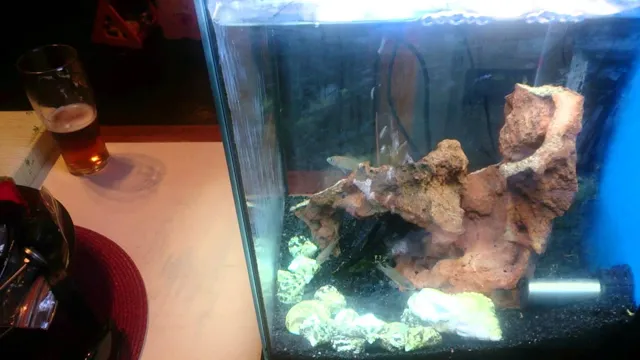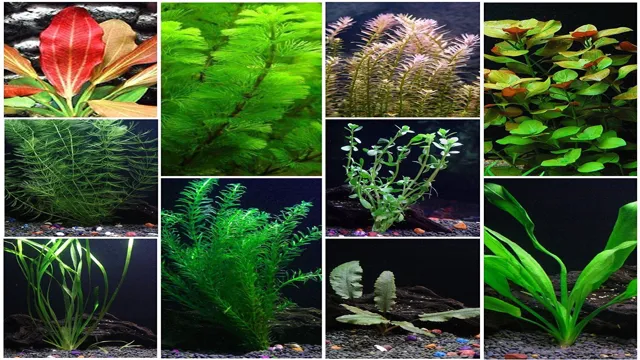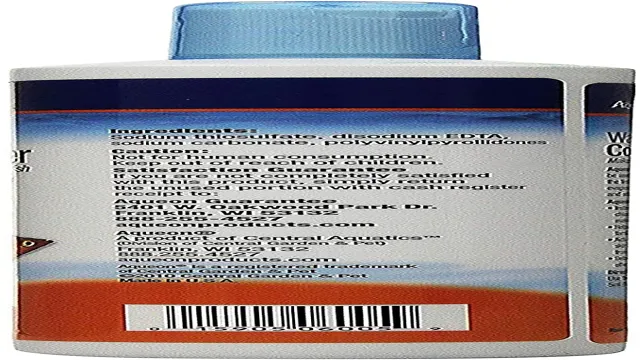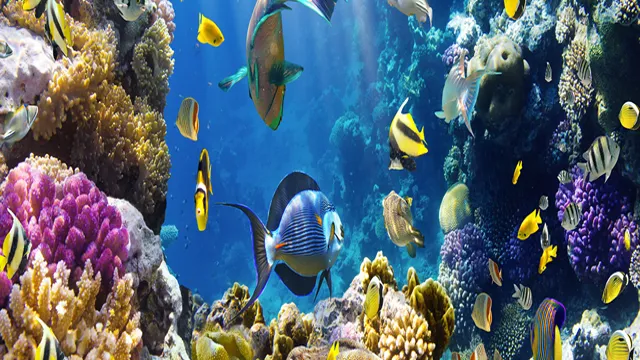Are you tired of seeing a white film cover the surfaces of your aquarium, making it look dirty and unappealing? Well, you’re not alone. This common problem can be caused by a variety of issues, including excess nutrients in the water, poor filtration, and inadequate lighting. But don’t worry, there are plenty of solutions to help decrease the white film in your aquarium and restore its clarity.
Think of the white film in your aquarium like a layer of dust on your furniture. Just like you wouldn’t want to live in a house full of dust and debris, your fish also require a clean and healthy environment to thrive. By identifying the root cause of the white film and taking action to address it, you can maintain a beautiful and inviting aquarium that your fish will love.
In this blog post, we’ll explore the most common causes of white film in aquariums and provide tips and tricks for reducing and preventing it from occurring. From adjusting your water chemistry to cleaning your aquarium equipment, we’ll cover everything you need to know to keep your aquarium looking its best. So, let’s dive in and learn how to decrease the white film in your aquarium once and for all!
Understanding White Film in Aquariums
If you’ve noticed a white film forming on the surface of your aquarium water, don’t worry – this is a common issue that many aquarium owners face. This layer of film is actually a buildup of oils, proteins, and other organic compounds that can accumulate due to overfeeding or inadequate water circulation. To decrease the amount of white film in your aquarium, there are several steps you can take.
First, try reducing the amount of food you’re feeding your fish, as excess food can contribute to the buildup of organic matter. Additionally, consider installing a surface skimmer or increasing the flow rate of your filter to improve water circulation and remove excess waste from the surface of the water. Regular water changes and thorough cleaning of aquarium equipment can also help prevent the buildup of white film.
By taking these steps, you can keep your aquarium clean and clear for both you and your fish to enjoy.
Causes of White Film in Aquariums
If you’re an aquarium owner, you may have experienced the frustration of noticing a white film forming on the surface of the water. Not only does it look unsightly, but it can also harm your aquatic pets. Understanding the causes of this issue is key to preventing it from occurring in the future.
One possible cause could be due to excess protein in the water, which can create a film as the proteins break down. Another possibility is that your aquarium may have high levels of dissolved organics, such as waste and uneaten food, which can contribute to the growth of bacteria and fungi that produce the film. Lastly, low water circulation or a lack of surface agitation could also be to blame, as this can lead to stagnant water and promote bacterial growth.
By being mindful of these causes and taking preventative measures, such as regular water changes and proper filtration, you can keep your aquarium looking its best and keep your aquatic pets healthy and happy.
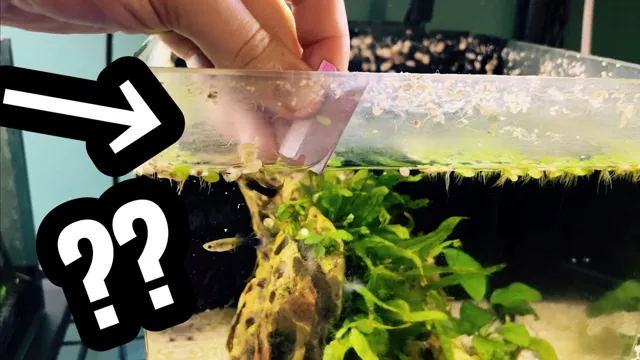
Effects of White Film in Aquariums
White film in aquariums is a common issue that many aquarium enthusiasts have to deal with. This white film can be caused by a variety of factors such as poor water circulation, overfeeding, or bacterial blooms. The film can be unsightly and may cause panic among aquarium owners, but it is not harmful to the aquarium inhabitants.
In fact, the film is usually made up of bacteria and other microorganisms that are an essential part of the aquarium’s ecosystem. However, if the buildup becomes excessive, it can cause a lack of oxygen in the water, leading to potential harm to the fish and other living organisms in the tank. It is essential to identify the root cause of the white film and take necessary measures to prevent or eliminate it.
This may include increasing water circulation, reducing feeding, or adding a bacterial supplement to the water. With proper care and maintenance, an aquarium owner can keep their tank healthy and free from the unsightly white film. (See Also: How to Put a Fish in an Aquarium Wizard101: A Step-by-Step Guide for Beginner Players)
Effective Ways to Decrease White Film in Aquariums
If you’re a new aquarium owner, the sight of a white film developing on the surface of your aquarium can be alarming. Not to worry, there are some simple and effective ways to reduce this unsightly buildup. First, try reducing the amount of food you’re putting into your aquarium.
Overfeeding your fish can contribute to the development of white film. Second, consider adding some surface agitation to your aquarium. This can be done by adding an air stone or surface skimmer to your setup, which will help break up the film.
Third, check your water quality regularly. Poor water quality can contribute to the development of white film, so make sure you’re keeping up with regular water changes and maintenance. Lastly, consider adding some aquarium plants or algae eaters to your setup.
These organisms can help absorb excess nutrients and contribute to a healthier aquarium environment. By following these simple tips and tricks, you’ll be well on your way to a clearer and cleaner aquarium with less white film buildup.
Cleaning the Aquarium Regularly
If you’re experiencing a white film in your aquarium, there are a few things you can do to combat it. Firstly, it’s important to note that this film is likely caused by excess nutrients in your tank, such as phosphates and nitrates. To decrease these levels, consider changing up your cleaning schedule.
Regularly clean your aquarium’s filter and make partial water changes to help reduce these levels. Another effective way to decrease the white film is by adding live plants to your aquarium. Plants will naturally absorb excess nutrients, helping to keep the water cleaner for longer periods.
Lastly, consider reducing the amount you feed your fish, as uneaten food can contribute to excess nutrients. By implementing these steps, along with continued monitoring and maintenance, you should be able to decrease the appearance of that pesky white film in your aquarium.
Reducing Feedings
Reducing Feedings If you notice a white film building up on your aquarium glass or decorations, it may be time to re-examine your feeding habits. One effective way to decrease this unsightly film is to reduce the amount and frequency of feedings. Overfeeding can lead to excess nutrients in the water, which can promote the growth of algae and bacteria.
It’s important to remember that fish can go longer periods without food than you might think. Try skipping a day or two each week and see if that helps reduce the film. Another option is to feed smaller amounts more frequently throughout the day, as opposed to one large feeding.
This can help prevent excess food from settling on the bottom of the tank and contributing to the film. Remember, a little moderation can go a long way in keeping your aquarium clean and healthy.
Using a Protein Skimmer
If you are struggling with white film in your aquarium, one effective solution is to use a protein skimmer. This specialized equipment helps remove organic waste from the water that can cause the film to form. By effectively removing unwanted materials, the skimmer can prevent the buildup of organic material and keep your water looking clean and clear. (See Also: How to Make an Aquarium Filter with a Bottle: DIY Step-by-Step Guide)
Additionally, a protein skimmer can help increase oxygen levels in the water, which can be beneficial for your aquatic pets and plants. Consider adding a protein skimmer to your aquarium setup to help keep your water clean, clear, and healthy.
Proper Maintenance to Prevent White Film in Aquariums
If you’ve noticed a white film building up on the surface of your aquarium, don’t fret. This is a common problem caused by excess protein and organic matter. However, this issue can be easily prevented with proper maintenance practices.
Regularly cleaning your aquarium is key to decreasing the amount of protein and organic matter present in the water. This includes weekly water changes, vacuuming the gravel, and removing any uneaten food or debris. Additionally, investing in a good quality protein skimmer can help remove excess waste and further prevent the buildup of the white film.
Lastly, be mindful of overfeeding your fish, as this can greatly contribute to the problem. By following these maintenance tips, you’ll be able to decrease the appearance of the white film in your aquarium and maintain a healthy environment for your aquatic friends.
Maintain Proper Water Parameters
Proper maintenance and monitoring of water parameters are critical in preventing the build-up of white film in aquariums. This thin layer of white film is usually caused by an accumulation of organic waste, including uneaten food, dead fish, and other debris. The excess nutrients lead to the growth of bacterial colonies, which eventually form the white film.
To prevent this from happening, aquarium owners should be vigilant in checking and maintaining water parameters, such as pH, ammonia, nitrite, and nitrate levels. Ensuring proper filtration and regular water changes help remove excess waste and debris from the tank, reducing the likelihood of bacterial growth. Additionally, avoiding overfeeding and maintaining an appropriate fish population can also prevent excess organic waste.
By keeping a watchful eye on the water parameters and practicing proper maintenance, aquarium owners can enjoy a healthy and clean aquarium without the nuisance of unsightly white film.
Checking and Changing Water Filtration Media
Maintaining the quality of aquarium water is crucial for keeping your fish healthy. One common issue in aquariums is the appearance of a white film on the water surface. This is typically caused by an imbalance in the water’s chemistry and can lead to a number of health problems for your fish.
To prevent this from happening, it’s essential to properly maintain your aquarium’s water filtration system. This includes regularly checking and changing the water filtration media. Over time, these materials can become clogged with debris and other impurities, reducing their effectiveness.
By replacing them on a regular schedule, typically every 1-3 months, you can ensure that your aquarium’s water remains clear and free of harmful substances. This can help to prevent the white film from forming, keeping your fish happy and healthy.
Conclusion
In summary, reducing the unsightly white film in your aquarium requires a combination of good water maintenance practices, proper feeding habits, and the occasional use of cleaning agents. Remember to vacuum your substrate regularly, avoid overfeeding your fish, and keep your filter and other equipment clean to maintain a healthy aquarium environment. With a little effort and a lot of love for your aquatic pets, you can banish that pesky white film once and for all. (See Also: How to Prepare Moss Balls for Aquarium: A Step-by-Step Guide to a Healthy Aquatic Environment)
Your fish will thank you for it, and your guests will wonder how you managed to keep your aquarium looking so shiny and beautiful!”
FAQs
What causes white film to form in an aquarium?
White film in an aquarium is caused by the accumulation of excess nutrients and organic waste which encourage the growth of bacteria and other microorganisms.
How can I reduce the formation of white film in my aquarium?
To reduce the formation of white film in your aquarium, you should increase water circulation, perform regular water changes, reduce the amount of food given to your fish, and use a protein skimmer or other filtration methods.
Will adding aquarium plants help to decrease white film in my aquarium?
Yes, adding live aquarium plants can help to decrease the formation of white film in your aquarium by consuming excess nutrients and organic waste from the water.
Can overfeeding my fish cause white film to form in my aquarium?
Yes, overfeeding your fish can cause white film to form in your aquarium by introducing excess nutrients and organic waste into the water.
Is it safe to use chemical additives to control white film in my aquarium?
It is not recommended to use chemical additives to control white film in your aquarium as they can harm your fish and other aquatic life.
How often should I clean my aquarium to prevent the formation of white film?
You should perform regular maintenance on your aquarium, including cleaning and water changes, to prevent the formation of white film. The frequency of cleaning will depend on the size of your aquarium and the number of inhabitants.
Can a dirty aquarium cause health problems for my fish and other aquatic life?
Yes, a dirty aquarium can cause health problems for your fish and other aquatic life by increasing the levels of ammonia, nitrite, and nitrate in the water, which can be toxic to aquatic life.

